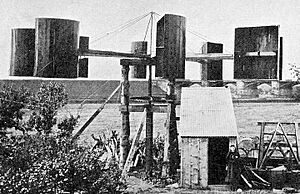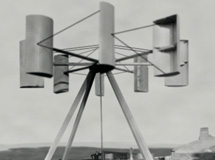James Blyth (engineer) facts for kids
Quick facts for kids
James Blyth
|
|
|---|---|
| Born | 4 April 1839 Marykirk, Kincardineshire
|
| Died | 15 May 1906 (aged 67) Glasgow, Renfrewshire
|
| Nationality | Scottish |
| Occupation | Engineer |
| Known for | Early pioneer of generation of electricity by wind power |
Professor James Blyth (born April 4, 1839 – died May 15, 1906) was a clever Scottish engineer and teacher. He worked at Anderson's College in Glasgow, which is now the University of Strathclyde. James Blyth was a pioneer in making electricity from wind power.
His wind turbine, which he used to light his holiday home, was the first known machine in the world to create electricity from wind. Blyth patented his design. He later made an even better model. This improved wind turbine provided emergency power for a hospital in Montrose for 30 years! Even though Blyth was recognized for his amazing work, people thought making electricity from wind was too expensive. Because of this, no more wind turbines were built in the United Kingdom until 1951, which was 64 years after Blyth built his first one.
Contents
Early life and education
James Blyth was born in Marykirk, Kincardineshire, Scotland, on April 4, 1839. His father, John Blyth, was an innkeeper and a small farmer. James went to school in Marykirk and then to Montrose Academy.
In 1856, he won a scholarship to a special teaching school in Edinburgh. He later graduated from The University of Edinburgh in 1861. After that, Blyth taught math at Morrison's Academy in Crieff. He also helped set up the science and technology lessons for the new George Watson's College in Edinburgh.
In 1871, James Blyth completed his Master of Arts degree. In the same year, he married Jesse Wilhelmena Taylor. They had two sons and five daughters. Sadly, two of their daughters passed away when they were babies.
Career and wind power inventions
In 1880, James Blyth became a professor at Anderson's College in Glasgow. This college later became the Glasgow and West of Scotland Technical College. While teaching, he did a lot of research. He was especially interested in making and storing electricity from wind power.
His students and colleagues liked Blyth very much. They admired how hard he worked and how down-to-earth he was. He was also well-known in the local community. He gave many popular talks and showed off his inventions.
In July 1887, Blyth built a wind turbine with cloth sails. He put it in the garden of his holiday cottage in Marykirk. He used the electricity it made to charge special batteries. This stored electricity then powered the lights in his cottage. This made his house the first in the world to be lit by wind-generated electricity!
In a talk in 1888, Blyth described his wind turbine. It had a tripod shape and was about 33 feet tall. It had four arms, each 13 feet long, with canvas sails. A special machine called a dynamo was connected to it. This turbine made enough power to light ten 25-volt light bulbs when there was a "moderate breeze." It could even power a small machine for shaping wood.
Over the next few years, Blyth tried out many different designs for his wind turbine. His final design worked for 25 years! It even made extra electricity. Blyth offered this extra power to the people of Marykirk to light their main street. But they said no! They thought electricity was "the work of The Devil."
Blyth received a patent for his "wind engine" in November 1891. In 1895, he allowed an engineering company in Glasgow to build a second, improved turbine. This new turbine was used to provide emergency power to a hospital in Montrose. This system worked well for the next 30 years.
Blyth's first wind generator was the first known machine to create electricity from wind. However, it didn't have a way to stop itself in strong winds. This meant it could get damaged. A few months after Blyth built his first machine, an American named Charles F. Brush built the first automatically operated wind turbine. Brush's machine could be shut down by hand to protect it from strong winds. The improved design of Blyth's turbine for the Montrose hospital was better, but it still couldn't always stop itself in very strong winds.
In 1891, Blyth gave a talk where he shared his belief in the benefits of clean energy sources. He especially believed in wind power, but also wave energy. Later that year, he received a special award for his work in making electricity from wind. However, his wind turbine was not seen as a good way to make money at the time.
Blyth also researched other things. He looked into how well different types of lighting worked. He also studied telephone communication and microphones. He even wrote articles for a famous encyclopedia.
Later life and legacy
Blyth's son, Vincent James, and his son-in-law, George Edwin Allan, both became teachers and assistants in the Natural Philosophy department. In 1900, Blyth received an honorary doctorate degree from the University of Glasgow. He passed away in Glasgow on May 15, 1906, from a sudden illness. His friend James Colville remembered him as "a true man of science." He said Blyth used his cleverness and hard work to explain many facts about physical science.
After Blyth passed away, a committee was set up in 1907 to remember him. They raised money for a memorial. This memorial became the Blyth Memorial Prizes for students and a plaque on the college wall. The wind turbine at the Montrose hospital was taken down in 1914. Britain's first public wind turbine for electricity didn't start working until 1951. This was a prototype turbine built by a Glasgow company and installed in Costa Head, Orkney.
Honours
In 2021, James Blyth was honored by being added to the Scottish Engineering Hall of Fame.
See also
- History of wind power
- Wind power in Scotland
- Wind turbine
Images for kids





